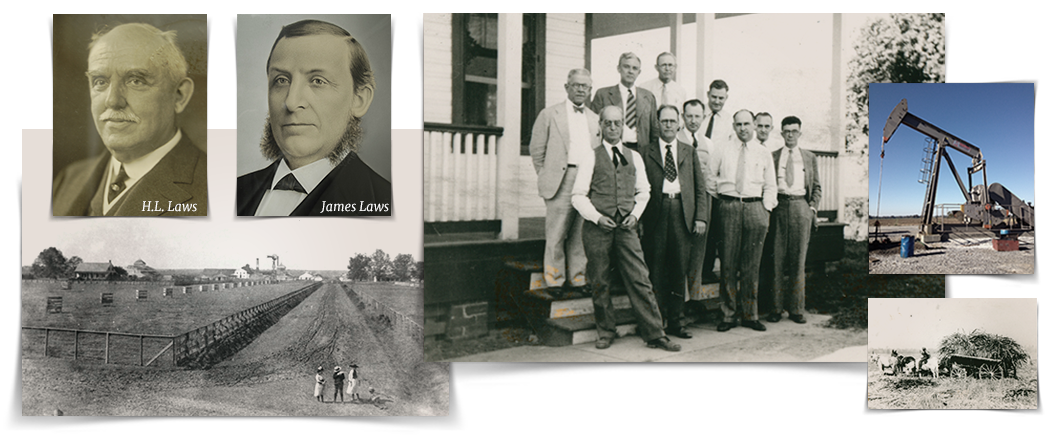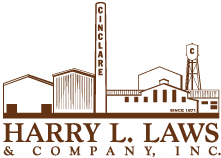
About


A land, a family, and a legacy…
Founded by the original owner of Cinclare Plantation and Sugar Mill, the multi-generation, family-owned firm of Harry L. Laws & Company has over 130 years of experience in managing a varied portfolio of properties across south Louisiana. In addition to nearly 13,000 acres of agricultural holdings – primarily devoted to sugar cane – in West Baton Rouge, Iberville and St. Mary Parishes, HLL&C’s diverse interests include significant acreage in hunting and timber leases, crawfish ponds and mitigation banks, as well as other properties. As it has since the mid-nineteenth century, the company continues to play a prominent role in the local sugar industry as majority owner of the Catherine Sugar Company in West Baton Rouge Parish.
Pre-1803
The four separate tracts of farmland that will eventually become Cinclare, then owned by Jacques Molaison, Louis Daigle, Valentin Hebert and Almee Lycoade, are producing sugar cane.
1855
Emile Trinidad and Thomas Mille acquire the four tracts to create one single plantation, named Marengo. The “main house”, a Greek Revival-style residence, is constructed.
Pre-1865
Before the war, most sugar plantations maintain mills on property, capable of extracting raw sugar from cane, which is then shipped to refineries for conversion into table-ready product.
Post-1865
After the Civil War ends and faced with a shortage of labor and capital, smaller sugar mills fail and close, forcing planters to transport harvested cane to larger, sometimes distant mills for processing.
1878
In settlement of notes due on borrowed money during a difficult period in the sugar industry, Cincinnati, Ohio-based James Laws & Co. acquires Marengo, renamed Cinclare by company owner James Laws in honor of his New Orleans-based business partner, Lafayette Cinclare Keever. With capital available and sensing an opportunity due to the lack of a large mill in the vicinity, Laws expands operations, transforming Cinclare into one of the area’s major milling resources.
1897
Laws demolishes Cinclare’s old open kettle mill, replacing it with a more modern factory operation.
1906
Mill operations undergo further expansion and the “main house” is moved to a new location on Managers’ Row within the rapidly growing company town area. On the original “main house” site, Laws constructs a Queen Anne-style home, recalling the architecture of the New England summer retreats Laws and his family frequented.
Circa 1910s
James Laws’ son, Harry L. Laws assumes the title of company president and the firm name is subsequently changed to reflect his new role.
1915
Using his influence as member of the Texas & Pacific Railroad’s board of directors, Langdon persuades the company to construct a spur from its nearby main line to a point close to the mill, allowing the company to easily transport sugarcane from nearby plantations, boost capacity, and ship milled sugar to distant refineries for final processing.
1930s
State Highway 1, commonly known as “LA1”, is built, allowing for easier access to Cinclare and other plantations along the river. With the increased use of trucks for farm transportation, use of the railroad spur gradually declines.
1950
Cinclare’s iconic landmark, its 210-foot tall smokestack, is constructed.
Circa 1955
Stuart B. Sutphin, Jr., grandson of H.L. Laws, Sr., assumes company presidency after death of H. Langdon Laws, Jr. E. Berkshire Terrill Jr. succeeds Sutphin as company president in 1958.
1960s-1970s
As alternative, high yield crops such as soybeans become more prevalent and the surrounding parishes move to a more industrial-based economy, the number of farms producing sugar cane decreases. Over the next few decades, this reduction – along with improvements in transportation and processing technology – will lead to an eventual decrease in the number of operating mills.
1982
Glenn Timmons is appointed president of HLL&C, succeeding E. Berkshire Terrill Jr.
1998
The Cinclare Sugar Mill is designated as a Historic District and placed on the National Register of Historic Places.
2005
Cinclare announces that under a lease-purchase agreement, its 19th-century mill will consolidate operations with Pointe Coupee Parish-based Alma Plantation, LLC. As part of the consolidation plan, Cinclare ceases operations once the process is completed. As a result of the transaction and closure, HLL&C moves out of refining, expanding its sugar cane farming operations.
2007
Butch Plauché succeeds Glenn Timmons as president of HLL.
2010s
As the region’s burgeoning film industry continues to thrive, the former mill becomes a popular venue for film location shoots. Productions filmed at Cinclare include Winged Terror, Leprechaun’s Revenge, Carjacked, and Bonnie & Clyde to name a few.
2013
Partnering with noted town planner and architect Steve Oubre, Harry L. Laws & Company announces plans for a new traditional neighborhood development on 275 acres near historic Cinclare Plantation. The development will maintain and preserve much of the historic flavor of the area, while incorporating innovative principles of new urbanism, with an emphasis on sustainability and environmental stewardship.
